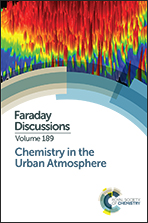Biofuels, vehicle emissions, and urban air quality
Abstract
Increased biofuel content in automotive fuels impacts vehicle tailpipe emissions via two mechanisms: fuel chemistry and engine calibration. Fuel chemistry effects are generally well recognized, while engine calibration effects are not. It is important that investigations of the impact of biofuels on vehicle emissions consider the impact of engine calibration effects and are conducted using vehicles designed to operate using such fuels. We report the results of emission measurements from a Ford F-350 fueled with either fossil diesel or a biodiesel surrogate (butyl nonanoate) and demonstrate the critical influence of engine calibration on NOx emissions. Using the production calibration the emissions of NOx were higher with the biodiesel fuel. Using an adjusted calibration (maintaining equivalent exhaust oxygen concentration to that of the fossil diesel at the same conditions by adjusting injected fuel quantities) the emissions of NOx were unchanged, or lower, with biodiesel fuel. For ethanol, a review of the literature data addressing the impact of ethanol blend levels (E0–E85) on emissions from gasoline light-duty vehicles in the U.S. is presented. The available data suggest that emissions of NOx, non-methane hydrocarbons, particulate matter (PM), and mobile source air toxics (compounds known, or suspected, to cause serious health impacts) from modern gasoline and diesel vehicles are not adversely affected by increased biofuel content over the range for which the vehicles are designed to operate. Future increases in biofuel content when accomplished in concert with changes in engine design and calibration for new vehicles should not result in problematic increases in emissions impacting urban air quality and may in fact facilitate future required emissions reductions. A systems perspective (fuel and vehicle) is needed to fully understand, and optimize, the benefits of biofuels when blended into gasoline and diesel.
- This article is part of the themed collection: Chemistry in the Urban Atmosphere

 Please wait while we load your content...
Please wait while we load your content...